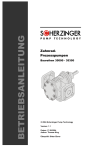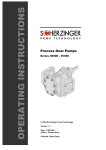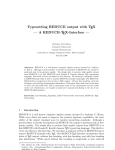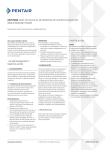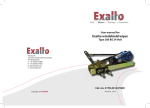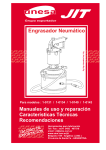Download Operating Instructions Rotary Gear Pumps Models
Transcript
Rotary Gear Pumps 51-551 Operating Instructions Rotary Gear Pumps Models: 51, 76, 101, 151, 251, 351, 451, 551 date of issue: 04.07.00 Seite 1 / 1 release:2 written by: King checked by: Pumpenfabrik Ernst Scherzinger GmbH & Co. KG • Bregstr. 23-25 • 78120 Furtwangen/ Germany Tel.: +49 (0) 77 23 – 65 06-0 • Fax: 65 06-40 • E-Mail: [email protected] Rotary Gear Pumps 51-551 0. Contents 0. Contents ................................................................................................................................................................................. 2 1. General ................................................................................................................................................................................... 3 1.1. Usage ............................................................................................................................................................................. 3 1.2. Pump Model Designation ................................................................................................................................................ 3 1.3. Pump Data ...................................................................................................................................................................... 3 1.4. Representatives .............................................................................................................................................................. 4 2. Safety...................................................................................................................................................................................... 4 2.1. Symbols Used In These Operating Instructions .............................................................................................................. 4 2.2. Personnel Qualification ................................................................................................................................................... 5 2.3. Possible Dangers If Safety Warnings Are Not Observed ................................................................................................ 5 2.4. Local Safety Regulations ................................................................................................................................................ 5 2.5. Safety Guidelines For The Operator ............................................................................................................................... 5 2.6. Safety Guidelines For Maintenance, Assembly and Disassembly................................................................................... 5 2.7. Technical Changes And Manufacturing Of Spare Parts.................................................................................................. 5 2.8. Inadmissible Operation ................................................................................................................................................... 5 3. Transportation And Storage .................................................................................................................................................... 6 3.1. Shipping .......................................................................................................................................................................... 6 3.2. Transportation................................................................................................................................................................. 6 3.3. Storage ........................................................................................................................................................................... 6 3.4. Preparation For Storage After Use.................................................................................................................................. 6 4. The Pump ............................................................................................................................................................................... 6 4.1. Principle Of A Gear Pump............................................................................................................................................... 6 4.2. Design of the Lubrication Pumps .................................................................................................................................... 7 4.2.1. General Design ....................................................................................................................................................... 7 4.2.2. Directions of Flow.................................................................................................................................................... 9 4.2.3. Internal Relief Valve ................................................................................................................................................ 9 4.2.4. Shaft Seals And Bearings ....................................................................................................................................... 9 4.3. Dimensions ................................................................................................................................................................... 10 5. Installation............................................................................................................................................................................. 10 5.1. Place Of Installation ...................................................................................................................................................... 10 5.2. Tools ............................................................................................................................................................................. 10 5.3. Initial Installation ........................................................................................................................................................... 10 5.3.1. Check Before Installation ...................................................................................................................................... 10 5.3.2. Pump With Motor .................................................................................................................................................. 11 5.3.3. Pumps For Foot Mounting..................................................................................................................................... 11 5.3.4. Mounting C - Face Pumps (F - Version)................................................................................................................ 12 5.3.5. Motor Assembly Of C – Face Pumps (ZK - Version)............................................................................................. 12 5.3.6. Electric Connection ............................................................................................................................................... 14 5.3.7. Piping .................................................................................................................................................................... 14 6. Start UP / Shut Down............................................................................................................................................................ 14 6.1. Prepare For Operation .................................................................................................................................................. 14 6.2. Start Up......................................................................................................................................................................... 15 6.3. Relief Valve................................................................................................................................................................... 15 6.4. Monitoring ..................................................................................................................................................................... 16 6.5. Shut – Down ................................................................................................................................................................. 16 6.6. Dismounting .................................................................................................................................................................. 16 7. Maintenance ......................................................................................................................................................................... 17 7.1. General Information ...................................................................................................................................................... 17 7.2. Inspection...................................................................................................................................................................... 17 7.3. Repair Work .................................................................................................................................................................. 17 7.4. Tools ............................................................................................................................................................................. 17 Seite 2 / 2 Pumpenfabrik Ernst Scherzinger GmbH & Co. KG • Bregstr. 23-25 • 78120 Furtwangen/ Germany Tel.: +49 (0) 77 23 – 65 06-0 • Fax: 65 06-40 • E-Mail: [email protected] Rotary Gear Pumps 51-551 1. General This manual includes all necessary information required during installation, operation and maintenance. It Should be read prior to commencing installation and operation. It is absolutely necessary to store the manual within reach of the pump. In additional to this manual, the operating instructions of the motor should be read and always be kept within reach of the pump. 1.1. Usage Pumps described in these operating instructions are capable of pumping lubricating liquids. All liquids must be non - corrosive for the used materials (see section 1.3). Should you require any additional information regarding the pump, contact Scherzinger Pumpen GmbH & Co. KG, Scherzinger Pump Technology Inc. or their local authorized distributor. Please state the pump model and the date of manufacture in your correspondence. 1.2. Pump Model Designation This manual is valid for the lubrication pumps 51, 76 102, 151, 251, 351, 451 and 551 beginning with the year 1998, manufactured by Ernst Scherzinger GmbH & Co KG, 78120 Furtwangen, Germany. The date of manufacture is stamped on the casing. The first letter marks the year of manufacturing, the following number the month of manufacturing. To determine the year, we started in 1997 with the letter F was used (G:1998, H:1999, I:2000, etc.). The bottom line of this manual shows the issue and date of issue of this operating instruction. All the described motor pumps in these operating instructions conform with valid EG - laws and are allowed to carry the CE symbol. 1.3. Pump Data Max. Operating Pressure (outlet side) Max. System Pressure (inlet side) Max. Suction Max. Pressure Rise Flow Rate at 1400 RPM, 50mm²/s and 2 Bar Pressure Rise Storage Temperature Operating Temperature Viscosity Range Speed Range Seite 3 / 3 30 Bar (435 psi) 0,2 Bar (3 psi) 20 Bar (290 psi) 25 Bar (363 psi) -0,4 Bar (-6 psi) -0,8 Bar (-11,5 psi) 30 Bar (435 psi) 10 Bar (145 psi) 30 Bar (425 psi) Size 51 Size 76 Size 101 Size 151 Size 251 Size 351 Size 451 Size 551 +10 to +50°C (50 to 122°F) -20 to +80°C (-8 to 176°F) -10 to +160°C (-8 to 320°F) -20 to +100°C (-8 to 212°F) -20 to +60°C (-8 to 140°F) 2 to 3000 mm2/s 100 to 1800 RPMn (with Lip Seal Ring) (with Magnetic Drive) (with Packing) (with Lip Seal Ring) (with Magnetic Drive) (with Lip Seal Ring) (with Magnetic Drive) (with Packing) 2,8 l/min (0,73 GPM) 3,7 l/min (0,96 GPM) 5,2 l/min (1,35 GPM) 7,6 l/min (1,97 GPM) 16 l/min (4,16 GPM) 26 l/min (6,75 GPM) 43 l/min (10,9 GPM) 69 l/min (17,9 GPM) (Seals Buna N) (Seals Viton) (Seals PTFE) (Seals EPDM) Pumpenfabrik Ernst Scherzinger GmbH & Co. KG • Bregstr. 23-25 • 78120 Furtwangen/ Germany Tel.: +49 (0) 77 23 – 65 06-0 • Fax: 65 06-40 • E-Mail: [email protected] Rotary Gear Pumps 51-551 WARNING 1.4. Noise < 70 dB(A), Ground Gears, speed 1400 RPMn Pressure Rise 20 Bar, Operating Temperature 20°C, Liquid 200 mm²/s, Lubricant Dimensions Materials in Contact With Liquid see data sheets Casing Cover Shafts Gears Seals Liquids Motors See Quotation C-Face or bare shaft pumps are delivered without electric motor. For motor pumps see specification of drive manufacturer or distributor Cast Iron GG-25 Cast Iron GG-25 Case Hardened Steel Case Hardened Steel Buna N (standard) PTFE (if requested) Viton (if requested) EPDM (if requested) If you intend to operate the pump outside of the above given parameters, please consult the manufacturer of the pump. Modifications may be necessary to ensure successful operation. Otherwise the pump or your system may be damaged. Representatives Please contact Scherzinger Pump Technology Inc. for the representative in your area. 2. Safety Equipment that is incorrectly installed, operated in a dangerous manner, or poorly maintained, is a potential safety hazard. If all reasonable precautions are not taken, the result may be personal injury or damage to equipment. 2.1. Symbols Used In These Operating Instructions These operating instructions contain safety regulations. If these regulations are ignored, the result may cause injury or death. Warnings are noted with the following symbols: danger symbol high voltage symbol symbol referred to DIN 4844 - W9 symbol referred to DIN 4844 – W8 Please pay close attention to items marked with the following symbol. Pump or system damage is possible if these warnings are ignored. WARNING Information plates attached directly to the pump: Sign with direction of rotation Declaration of fluid connections Date of manufacture Name plate This information must be observed and preserved. Seite 4 / 4 Pumpenfabrik Ernst Scherzinger GmbH & Co. KG • Bregstr. 23-25 • 78120 Furtwangen/ Germany Tel.: +49 (0) 77 23 – 65 06-0 • Fax: 65 06-40 • E-Mail: [email protected] Rotary Gear Pumps 51-551 2.2. Personnel Qualification Individuals responsible for operation, maintenance and assembly of this equipment require proper training. It is essential the operator is aware of proper operational methods. This operating manual must be read and understood before installing and operating the pump. 2.3. Possible Dangers If Safety Warnings Are Not Observed Failure to observe safety warnings may cause danger to the personnel, environment and the pump. Liability claims are also possible. Examples of such dangers are: Malfunction of the pump Electrical shock Mechanical failure Danger to the environment by leakage 2.4. Local Safety Regulations The installation and operation of the pump must comply with national and local health, legislation, and safety regulations. 2.5. Safety Guidelines For The Operator Protect hot or cold machine parts against touching. Leaking dangerous liquids (e.g. explosive, poisonous, hot) must be drained, to ensure they do not cause danger to personnel and the environment. Laws must be obeyed. Electrical dangers must be avoided. 2.6. Safety Guidelines For Maintenance, Assembly and Disassembly Maintenance, assembly and disassembly must be performed by skilled technicians, who have read these operating instructions. Perform all work while the pump is not in operation. If you are pumping noxious liquids, the pump must be decontaminated prior to performing maintenance. After completion of maintenance, all safety devices must be reinstalled. Prior to start up, all guidelines must be followed. 2.7. Technical Changes And Manufacturing Of Spare Parts It is necessary to consult the manufacturer prior to make modifications and technical changes to the pump. We recommend the use of spare parts produced by the manufacturer. The use of other parts will void your warranty. 2.8. Inadmissible Operation The safe operation of the pump model is only possible if the pump is operated in a correct manner according to section 1 - General – of this operating manual. The pump data in the data sheet must also be observed. Seite 5 / 5 Pumpenfabrik Ernst Scherzinger GmbH & Co. KG • Bregstr. 23-25 • 78120 Furtwangen/ Germany Tel.: +49 (0) 77 23 – 65 06-0 • Fax: 65 06-40 • E-Mail: [email protected] Rotary Gear Pumps 51-551 3. Transportation And Storage 3.1. Shipping The pumps are packaged to prevent corrosion (painted / if the pumps are not painted, they are oiled) and damage during shipment. Additionally, the inlet and outlet ports are plugged to prevent leakage of retained test liquid, protect the threads, and to prevent particles from reaching the internals of the pump. 3.2. Transportation To avoid shipping damage, protect the transportation box against impact. We guarantee that the pump at time of delivery was working well. The pump was packaged in a suitable transportation box. After receipt, inspect pump immediately for shipping damage. If you discover damage immediately contact the forwarder agent and/or supplier. 3.3. Storage If the pump is stored and will be used later heed to following points: Do not store the pump in wet or humid rooms Do not put mechanical load on the shaft end Let inlet and outlet ports plugged Storage temperature to section 1.3. If pumps should be stored than 6 months, metallic parts must be specially protected against corrosion. 3.4. Preparation For Storage After Use For shut-down and dismount see sections 6 and section 7. Depending on the liquid pumped, there are different methods for preparing the pump for storage. If liquids without poisonous or aggressive additives were pumped, flush the pump for one minute with at operating speed with new lubricating oil. If toxic or aggressive liquids were pumped, be sure to follow all safety precautions. First, flush the pump with a neutralizing liquid at operating speed. Parts such as the relief valve (section 6.3), magnetic coupling (section 4.2.4) and packing box (section 4.2.4), which cannot be cleaned completely by flushing the pump need to be disassembled and cleaned by hand. WARNING If liquids that solidify have been pumped (e.g. paint), completely disassemble the pump (section 7.3). Clean all parts by hand to guarantee a successful start up. Clean the pump with normal detergent (see resistance of pump materials). After assembly the pump should be flushed with a preserving oil at operating speed. When handling noxious liquids, adhere to all safety regulations! 4. The Pump 4.1. Principle Of A Gear Pump Gear pumps are rotary displacement pumps in which two gears engage with each other. The transfer of fluid is caused by counter rotation of two gears in a gear chamber. The gears are fixed on two shafts, which are running in bearings in the casing and the cover. The shaft drives one gear. The other is driven by the first gear. The opening teeth create a suction, which draws the liquid into the pump (figure 4.1). The liquid is transported between the teeth and the gear chamber to the pressure side (figure 4.2, figure 4.3). When the gear teeth mesh, the liquid is squeezed out and pressed into the discharge port (figure 4.4). In this way liquid can be pumped against pressure. Seite 6 / 6 Pumpenfabrik Ernst Scherzinger GmbH & Co. KG • Bregstr. 23-25 • 78120 Furtwangen/ Germany Tel.: +49 (0) 77 23 – 65 06-0 • Fax: 65 06-40 • E-Mail: [email protected] Rotary Gear Pumps 51-551 → → → 4.2. → → → → → → → → → → figure 4.1 figure 4.2 figure 4.3 figure 4.4 Design of the Lubrication Pumps 4.2.1. General Design The robust body consists of two parts: Casing 1 and cover 2. The pump design lends itself to easy, fast and economic maintenance. The cover is screwed with either four or six screws to the casing. The two parts are sealed an O - ring 3. The gears and the shafts are pressed together and run in sleeve bearings – the casing and the cover itself are the bearings. The torque is transmitted from the drive shaft with drive gear 4 to the idler shaft with idler gear 5. The standard shaft is a lip seal ring 6. Scherzinger lubrication pumps are available in eight different pump sizes (size 50 to size 550, flow rates see Pump Data, section 1.3) and four different mounting variations ( figure 4.5 to figure 4.8). The shown cut away drawings are valid for the pump sizes 151 and 251 and may vary in details for the other sizes. 2 3 1 4 5 Å 6 figure 4.5 – foot mounted pump with lip seal ring – e.g. to screw to a base plate Seite 7 / 7 Pumpenfabrik Ernst Scherzinger GmbH & Co. KG • Bregstr. 23-25 • 78120 Furtwangen/ Germany Tel.: +49 (0) 77 23 – 65 06-0 • Fax: 65 06-40 • E-Mail: [email protected] Rotary Gear Pumps 51-551 2 3 5 1 6 4 7 figure 4.6 – C-face pump with lip seal ring – to mount e.g. directly to a gear box 2 3 5 1 6 4 7 8 figure 4.7 – C-face pump with lip seal ring to mount directly to a DIN – motor 2 3 2 4 9 5 6 7 8 figure 4.8 – Pump with lip seal ring mounted to an electric motor Seite 8 / 8 Pumpenfabrik Ernst Scherzinger GmbH & Co. KG • Bregstr. 23-25 • 78120 Furtwangen/ Germany Tel.: +49 (0) 77 23 – 65 06-0 • Fax: 65 06-40 • E-Mail: [email protected] Rotary Gear Pumps 51-551 4.2.2. Directions of Flow Additional to the basic models of the pumps described in section 4.2.1, each pump is available with different directions of flow. If you look at the shaft end: Clockwise Rotation - Inlet Port to the Left Counter Clockwise Rotation - Inlet Port to the Right If direction of rotation changes and inlet port to the left If direction of rotation changes and inlet port to the right 4.2.3. þ discharge port to the right þ discharge port to the left þ discharge port to the right þ discharge port to the left Internal Relief Valve The optional available internal relief valve protects your system against inadmissible high pressures. Depending on the needed cracking pressure, it can be set with different springs to pressures between 0 to 30 Bar (figure 4.9). While cracking, the valve relieves internally from pressure to suction side to protect the system and pump from damage. Refer to section 6.3 for Relief Valve adjustment. figure 4.9 4.2.4. Shaft Seals And Bearings The drive shaft can be sealed in different ways. In standard design the shaft is sealed by a lip seal ring (figure 4.10). This kind of sealing mostly is used for pumps with a low inlet pressure (-0,4 to 0,2 bar) and low viscous liquids (up to 700mm²/s). figure 4.10 If suction height reaches more than 4m up to 7m (-0,7 bar), often two Lip Seals are used. If the liquids to be pumped have poor lubrication qualities or is a highly viscous liquid, two lip seal rings are recommended. In this case the space between the two lip seals are filled with grease (figure 4.11). figure 4.11 figure 4.12 Seite 9 / 9 A Packing Box (figure 4.12) should be selected when the pump has to handle inlet pressure (up to 25 bar) or the liquids to be pumped are highly viscous (more than 1000mm²/s). If using high viscous liquids, reduced pump speeds are recommended. Advantages of Packing: It is easy to maintain. If it wears out and starts leaking, it easily can be tightened. Pumpenfabrik Ernst Scherzinger GmbH & Co. KG • Bregstr. 23-25 • 78120 Furtwangen/ Germany Tel.: +49 (0) 77 23 – 65 06-0 • Fax: 65 06-40 • E-Mail: [email protected] Rotary Gear Pumps 51-551 Absolute leak free operation only can be guaranteed if no rotating parts (e.g. shafts) have to be sealed. The Magnetic Coupled Pump (figure 4.13) is hermetically sealed. Pumps with a magnetic coupling transmit the torque from the driving motor to the pump by magnetic forces without contact. Magnetically coupled Rotary Gear Pumps can handle a system pressure up to 20 bar (inlet pressure) and a differential pressure of -0,8 to 10 bar. Operation of the magnetic coupling is only allowed up to the operating temperature of the used magnets (150°C). figure 4.13 In some applications, the pumps must be driven e.g. with a belt drive. This creates an additional radial force to the shaft bearings. For Belt Drive applications, the pumps can be ordered with an additional Ball Bearing (figure 4.14). Allowed radial forces at a speed of 1450 RPM and a lifetime of 10.000h, force points to the middle of the feather key: figure 4.14 4.3. 51: 76: 101: 151: 250 N 250 N 400 N 400 N 251: 351: 451: 551: 400 N 450 N 450 N 500 N Dimensions All relevant pump dimensions can be seen in the dimension sheets of the pumps. 5. Installation 5.1. Place Of Installation When choosing the place of installation make sure there is enough space around the pump for easy maintaining. The place of installation must be dry. Do not mount in aggressive environment. 5.2. Tools For mounting our gear pumps you need: A wrench for the piping A wrench or ring wrench for the mounting screws Allan key for the coupling 5.3. Initial Installation 5.3.1. Check Before Installation First check the pump for transportation damages (se section 3.2). Verify the following information, some items may not pertain to your pump model: Liquid to be pumped Pump data (flow rate, pressure rise, motor performance) Pump model and type Direction of rotation and position of inlet and outlet ports Type of Shaft Seal Additional Ball Bearing for shaft WARNING Seite 10 / 10 If there are differences between the pump required and the pump received please contact the manufacturer prior to starting the pump. Pumpenfabrik Ernst Scherzinger GmbH & Co. KG • Bregstr. 23-25 • 78120 Furtwangen/ Germany Tel.: +49 (0) 77 23 – 65 06-0 • Fax: 65 06-40 • E-Mail: [email protected] Rotary Gear Pumps 51-551 5.3.2. Pump With Motor When choosing a place for installation, be sure the motor-pump unit is mounted on an even surface. If necessary, use spacers near the mounting bolts 1 to ensure the unit is level. WARNING If you do not level the pump, mechanical stress may damage the motor or the pump or at least cause malfunctions. Tighten the mounting screws carefully 2 after having leveled the pump. WARNING Make sure the unit is proper ventilated to avoid overheating of the motor. WARNING Avoid mounting the pump with the pump head down. In this case the lip seal is bad lubricated and may fail. 1 2 figure 5.1 The four mounting screws 2 are not in the scope of supply. 5.3.3. Pumps For Foot Mounting a) Pump with coupling on base plate While assembling pump and motor make sure pump shaft and motor shaft are aligned well. There must be no radial or axial forces on both shafts. This can be avoided by using a flexible shaft coupling. Couplings of this type are available at Scherzinger. Aligning of pump and motor has to be done before connecting the piping (figure 5.2). The mounting bases of pump and motor must be parallel. For adjusting the height of the shaft, see dimension sheets of pump and motor. 1. 2. 3. 4. 5. 6. Bolt down the motor (usually the more weighty component) with all four screws 1. Fix the coupling parts with the stud screws to the shafts. Align the pump roughly. Screw in the fixing screws 2 for the pump. Pump must be easily to move. Turn drive shaft slowly (through fan shroud 3 or by turning the coupling on motor shaft 4) pump aligns now. Tighten screws 2. Make sure the pump does not move while doing this. The axial clearance between the shaft ends must be determined by the supplier of the coupling. WARNING Seite 11 / 11 To guarantee both units are aligned properly some experience is required. Is the alignment is done badly, the force on the shaft ends and the wear will be increased. The pump may fail. Pumpenfabrik Ernst Scherzinger GmbH & Co. KG • Bregstr. 23-25 • 78120 Furtwangen/ Germany Tel.: +49 (0) 77 23 – 65 06-0 • Fax: 65 06-40 • E-Mail: [email protected] Rotary Gear Pumps 51-551 5 4 2 3 1 figure 5.2 After assembly of the coupling, it is requested to protect the coupling e.g. by a coupling guard - see figure 5.2 - 5 against touching. b) Mounting a pump driven by a belt drive Driving pumps with a V-Belt Drive, Flat Belt Drive or multiple belt drive is only possible with pumps with an additional Ball Bearing for the shaft end (see section 4.2.4 - figure 4.14 and additional explanation). When calculating and choosing the belt drive, check the max. shaft end load of the used pump model. The pulley must be centered on the feather key (figure 5.3) and fixed safely. The more the pulley is shifted to the shaft end, the higher the bearing load and the less is the possible radial bearing load. figure 5.3 After assembly, protecting the belt drive by a guard against touching is absolutely necessary. 5.3.4. Mounting C - Face Pumps (F - Version) The way of mounting of c-face pumps differs with the application. A description how this pump has to be installed cannot be made. If you need help in your special case of installation, do not hesitate to contact Scherzinger Pumps. 5.3.5. Motor Assembly Of C – Face Pumps (ZK - Version) The delivered shaft coupling can be either consisting of two parts (see figure 5.4) that will be fixed to the shaft ends or three parts (see figure 5.5) with a flexible compensating element. Seite 12 / 12 Pumpenfabrik Ernst Scherzinger GmbH & Co. KG • Bregstr. 23-25 • 78120 Furtwangen/ Germany Tel.: +49 (0) 77 23 – 65 06-0 • Fax: 65 06-40 • E-Mail: [email protected] Rotary Gear Pumps 51-551 figure 5.4 figure 5.5 The coupling including the set screws are included. The coupling part of the pump is mounted in the correct position (figure 5.6 - length a). To mount the motor to the pump do as follows: 1. 2. 3. 4. 5. 6. Attach motor coupling 1 in distance b to the drive shaft. Fix coupling part with set screw 2 to shaft. Put motor 3 on fan shroud (shaft side up). If needed, put flexible compensating element to the coupling part. Attach pump with c-face flange 4 to the motor 3 (It may be helpful to turn the pump slightly). Fix pump with Screws 5 (not in scope of delivery) to the motor. 1 4 6 2 5 3 figure 5.6 Please use the following table to determine the dimensions of a and b in mm. All measures are valid for ISO motors, IMB 34 (tolerances due to ISO 7168): Pump Size 51 51 51 76 76 101 101 101 451 451 451 *) upon request Seite 13 / 13 Motor Size 63 71 0,25 63 71 63 71 80 80 90 100 a b Pump Size *) *) *) *) *) *) 6 5,5 2 3 *) *) *) *) *) *) *) -4 -3,5 0 3 *) 151 151 251 251 251 351 351 351 551 551 551 Motor Size 71 80 71 80 90 80 90 100 90 100 112 a b 6 5,5 1 5 2 2 2 *) *) *) *) -4 -3,5 0 3 -2 3 3 *) *) *) *) Pumpenfabrik Ernst Scherzinger GmbH & Co. KG • Bregstr. 23-25 • 78120 Furtwangen/ Germany Tel.: +49 (0) 77 23 – 65 06-0 • Fax: 65 06-40 • E-Mail: [email protected] Rotary Gear Pumps 51-551 5.3.6. Electric Connection Motor connections should be done in accordance with local laws and legislation. Also pay attention to the operating instructions of the motor. To receive the maximum motor torque, always use a delta connection. 5.3.7. Piping It is very important to install correct fittings to the pump. All fittings should screw together easily, use force only for final seat. WARNING Avoid pipe connections that place any external strains or loads on the pump. The piping must have a suitable inner diameter. The minimum diameter is the nominal widthof the pump connections. On the suction side of the pump, we recommend piping one size larger than the nominal width of the pressure side. As directional quantity we recommend following maximum flow velocities in the piping. Suction Piping Discharge Piping WARNING Up to 200 mm²/s 1,5m/s 3,0m/s Up to 600 mm²/s 1,0m/s 2,0m/s Up to 2000 mm²/s 0,5m/s 1,0m/s To protect the pump from damage caused by solids in the liquid, we recommend a 50-micron filter in the suction piping. Be sure the filter does not cause a serious pressure drop. Suction piping should be as straight and direct as possible to the pump with a minimum number of elbows. We recommend using long radius elbow type. The suction pipe should have a continuous rise to the pump. If it is necessary to install the piping rising and descending, there must be a provision to purge air at the highest points of the piping. WARNING After installing the piping, be sure it is free of sediments and chips. Otherwise the pump may be damaged. If the suction head will be greater than 4 meters, we recommend installing a check valve in the suction piping. Please contact the manufacturer for suction strainers with an integrated check valve in various sizes. Gear pumps must not operate against closed valves or a system closed to its discharge side. The pump can create a hazardous pressure rise, which can system environmental damage. We recommend a pump with an integrated relief valve, or a relief valve installed directly in the discharge pipe of the pump. In situations where de-aerating is a critical process, the installation of isolating valves, located directly before the inlet port and directly after discharge port is recommended. This allows for removal of the pump without draining the complete system. Pipes should be screwed together and not leak, otherwise air may penetrate into the pump, which will prevent the pump from sucking, or on the discharge side the liquid could drop out. It may be necessary to integrate silencers in the piping. 6. Start Up / Shut Down 6.1. Prepare For Operation After complete installation, before start up check the pump and the environment by following questions: Is it possible to turn the pump by hand (small pumps) or with a tool (big pump)? Are suction and pressure piping connected correctly? Do pump and drive have the same direction of rotation? Is the time of dry running restricted to a minimum? Are the pump internals wetted with the liquid to be pumped if the pump has to prime (max. dry running time 20 sec.)? are check valves, valves in right position? Seite 14 / 14 Pumpenfabrik Ernst Scherzinger GmbH & Co. KG • Bregstr. 23-25 • 78120 Furtwangen/ Germany Tel.: +49 (0) 77 23 – 65 06-0 • Fax: 65 06-40 • E-Mail: [email protected] Rotary Gear Pumps 51-551 Are the pipes checked for leakage? Is it possible to stop the pump by an emergency switch in case of malfunction? Is enough liquid in the reservoir? If temperature of pumps and liquid differ more than 50°C the pump has to be adapted in temperature! Are all rotating parts protected against touching? 6.2. Start Up Flush the system and the pump head with the liquid to be pumped. Adjust relief valve to wanted pressure according to section 6.3. Dry running time should not extend 20 seconds. WARNING 6.3. Relief Valve With the integrated relief valve it is possible to determine the relative pressure rise to exact value (see section 4.2.3). All relief valves are tested to ensure they are in good working condition. Relief valves are not set at a specific value, unless requested by the customer. The relief valve should be set while the pump is operating. Measure the pressure on the outlet side of the pump. Pay attention to do the adjustment with the correct operating conditions: Flow Rate Temperature System Pressure Speed of Rotation Correct Valve Spring Two different valve types are available: (figure 6.1 and figure 6.2) 1 2 3 4 5 6 7 8 9 figure 6.1 – relief valves of pump types 101, 151 and 251 Adjusting Valves of the Types 101, 151 and 251 1. Unscrew plug screw 1 and remove seal 2 2. Adjust the relief valve by turning the adjusting screw 2 with an Allan key • To the left (counter clockwise) => decreasing the crack pressure • To the right (clockwise) => increasing the crack pressure • Scherzinger recommends to set the crack pressure about 20% higher than the needed pressure rise 3. Replace plug screw 1 and seal 2 and tighten both Seite 15 / 15 Pumpenfabrik Ernst Scherzinger GmbH & Co. KG • Bregstr. 23-25 • 78120 Furtwangen/ Germany Tel.: +49 (0) 77 23 – 65 06-0 • Fax: 65 06-40 • E-Mail: [email protected] Rotary Gear Pumps 51-551 1 2 3 4 5 6 7 8 9 figure 6.2 - relief valves of pump types 51, 76, 351, 451 and 551 Adjusting Valves of the Types 51, 76, 351, 451 and 551 1. Unscrew and remove cap screw 1 and open counter nut 5 2. Adjust the relief valve by turning the adjusting screw 2 with a screw driver • To the left (counter clockwise) => decreasing the crack pressure • To the right (clockwise) => increasing the crack pressure • Scherzinger recommends to set the crack pressure about 20% higher than the needed pressure rise 3. Tighten counter nut 5 to fix the adjusting screw 4. Replace and tighten cap screw 1 5. Make sure all seals 4 are rearranged correctly While cap screw (plug screw) 1 is opened, a small amount of leakage is possible. WARNING The relief valve is designed for a short-term overload protection. Pumping liquid through a relief valve will generate heat in the liquid. For application at ambient operating temperatures, if the relief valve is opened more than 3 minutes, damage to the pump head could occur. The higher the operating temperature, the shorter the possible relief valve opening time. WARNING: do not remove adjusting screw while pump is in operation or the system is under pressure. Liquid can spurt out and cause personal injuries!! 6.4. Monitoring WARNING 6.5. We recommend installing a manometer on the outlet side of the pump to check the operating pressure. If the operating temperature is greater than 80°C we recommend installing a temperature gauge. Temperatures greater than 80°C (Buna N) or 160°C (Viton) may destroy the seals or damage the magnets (with magnetic coupling). Shut – Down Reduce the speed of rotation, if possible, to half operating speed. Drain the pump head by reducing the outlet pressure to atmospheric pressure and remove the suction piping out of the liquid tank so that the pump sucks air (not if the system is under pressure). Be sure the pump does not run dry for more than 30 seconds. If you are pumping noxious liquids, flush the pump with a neutralizing liquid. Flush the pump with lubrication oil (e.g. Shell GF68). 6.6. Dismounting Switch off drive motor and remove electric connections. Make sure all steps in section 6.5 have been completed. Remove the pump Seite 16 / 16 Pumpenfabrik Ernst Scherzinger GmbH & Co. KG • Bregstr. 23-25 • 78120 Furtwangen/ Germany Tel.: +49 (0) 77 23 – 65 06-0 • Fax: 65 06-40 • E-Mail: [email protected] Rotary Gear Pumps 51-551 7. Maintenance 7.1. General Information Be sure that the pump head is cleaned with a non-toxic liquid. In the event the pump head was operating with dangerous or noxious liquids, use necessary safety precautions. 7.2. Inspection All internal bushings are sleeve bearings, lubricated by the pumped liquid. Only one pump version (see section 4.2.4 - figure 4.14) is equipped with an additional ball bearing at the shaft end. Also for this type no maintenance is necessary. 7.3. Repair Work WARNING 7.4. If the pump head has been disassembled, it is necessary to replace all O–rings to ensure a proper seal. An exact description of the maintenance steps can, due to the various pump types, not be supplied. Please consult the matching spare part list. Tools For maintenance you will need: Allan key 2 to 10mm Wrench 8 to 40 mm Dynamometric key (3 to 40 Nm) pliers for retaining rings for shafts and bores (DIN471 / 472) pincers to remove the feather keys tool to press in the lip seal rings Seite 17 / 17 Pumpenfabrik Ernst Scherzinger GmbH & Co. KG • Bregstr. 23-25 • 78120 Furtwangen/ Germany Tel.: +49 (0) 77 23 – 65 06-0 • Fax: 65 06-40 • E-Mail: [email protected] Rotary Gear Pumps 51-551 Ernst Scherzinger GmbH & Co. KG Bregstrasse 23 78120 Furtwangen PO Box 11 54 78113 Furtwangen Telephone Telefax +49 / 0 77 23 / 65 06 –0 +49 / 0 77 23 / 65 06 – 40 Internet: E-Mail: http://www.scherzinger.de [email protected] Seite 18 / 18 Pumpenfabrik Ernst Scherzinger GmbH & Co. KG • Bregstr. 23-25 • 78120 Furtwangen/ Germany Tel.: +49 (0) 77 23 – 65 06-0 • Fax: 65 06-40 • E-Mail: [email protected]


















